- 1Pinterest
- 393Facebook
- 0Email
- 0Reddit
- 394shares
Did you know that the names of the city of Salzburg and the region of Salzkammergut come from Salt – which is one of the most important raw materials in Austria? Dubbed as the “white-gold”, it plays such an important part in the history of the region and Salzwelten in the oldest salt mine in the world. Hallstatt is more than a pretty lakeshore village although it has become a favorite destination for people(especially Photographers and Instagrammers) from all over because of its extremely striking position right on lake Hallstatter. Home to less than 1000 people, Hallstatt has been inhabited for thousands of years because it has bountiful deposits of natural salt that people living there always mined. A region in China has even built a full-scale replica of it but you will be better off to visit the real town for some unique adventures.
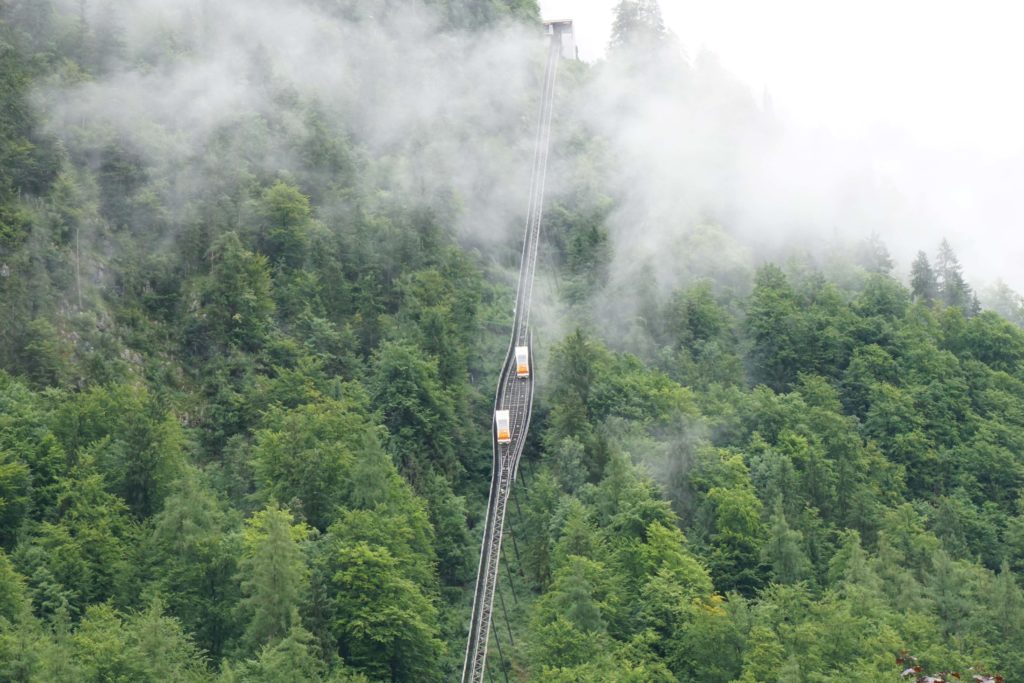
We arrived at Hallstatt after a picturesque drive from Salzburg, the clouds covering up most of the hills made for a rainy yet dreamy day. We decided to visit the Salt mine first and we’re hoping the rain would clear up by the time we got to visit the town center. We have seen so many pretty pictures of the stacked wooden houses of Hallstatt and wanted to see them for ourselves. We took the Funicular up the mountain, the glass-walled funicular turns what would be a 1-hour steep hike up the 1181 foot mountainside into a 3-minute scenic ride. The panoramic views down on to the lakeside village surrounded by the Alps are truly amazing while the funicular climbs up. Many visitors who have no intention of visiting the Salt Mine still make the quick trip up the funicular simply for the unbelievable views. You can take the funicular up the hillside then after the Hallstatt Salt Mine tour, follow the Salt Trail to hike back to the city center. The hike down takes 40-60 minutes or like us you’ll want to take the funicular round trip if you are short on time or if it is raining.
WHAT IS IN THIS POST
Rudolf’s Tower Restaurant near Salzwelten
Once you get off the funicular and take an elevator up, a pretty yellow greets all Salt Mine visitors. 1181 above Lake Hallstatt sits Rudolf Tower Restaurant with some amazing patio view. Walking to the tower itself is fun as you get to cross the Lookout Bridge spanning a small gorge sitting hundreds of feet below you. The tower, built in 1282, was constructed by Duke Albrecht I of Austria as a defense for the mine workers on Salzberg (salt mountain). He named the tower after his father Afder Rudolf I, the first leader of the Hapsburg empire. In 1313, the tower became the residence of the mine manager and remained so for more than 640 years. During this time many famous and important people visited the tower such as Emperor Maximilian. Johann Georg Ramsauer, the discoverer of the Hallstatt cemetery in 1833, renovated the tower and expanded the grounds after a fire claimed much of the area in the 1800s. The current restaurant was opened in 1960 and it is a great place to get some food before or after the Hallstatt salt mine tour.
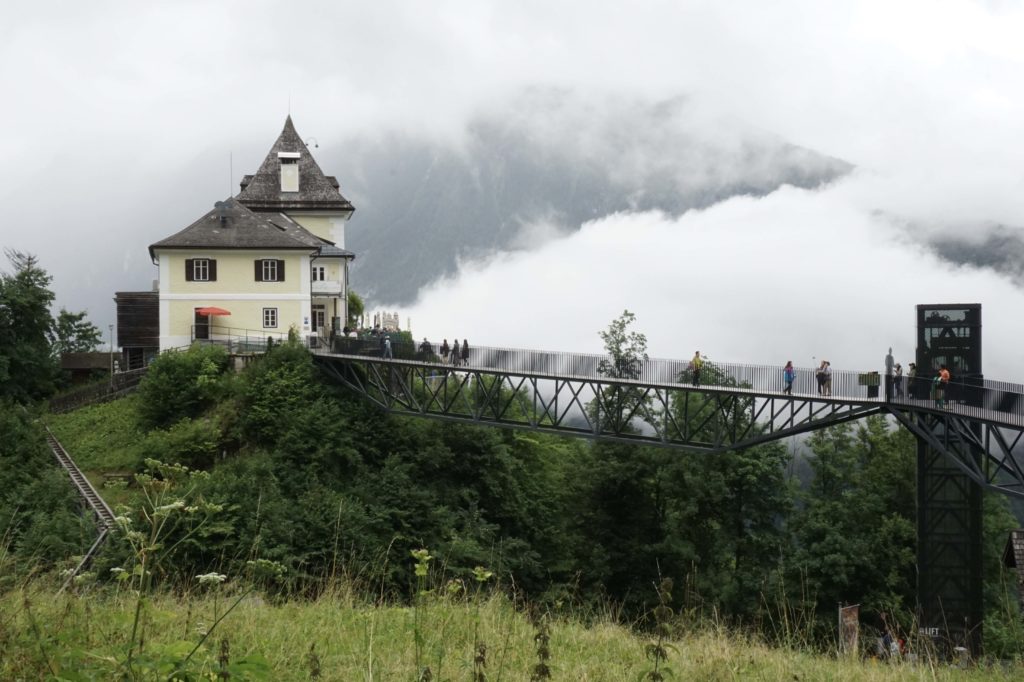
The Viewing Platform “Welterbeblick”
One of the most impressive lookout points in Hallstatt is from the patio of Rudolph’s Tower that that hangs over the cliff side. The V-shaped walkway juts out 1148 feet directly above the roofs of Hallstatt’s village and promises a World Heritage View and delivers much more. We walked up to the platform for some vertigo causing views of the lake, village, and surrounding mountains.
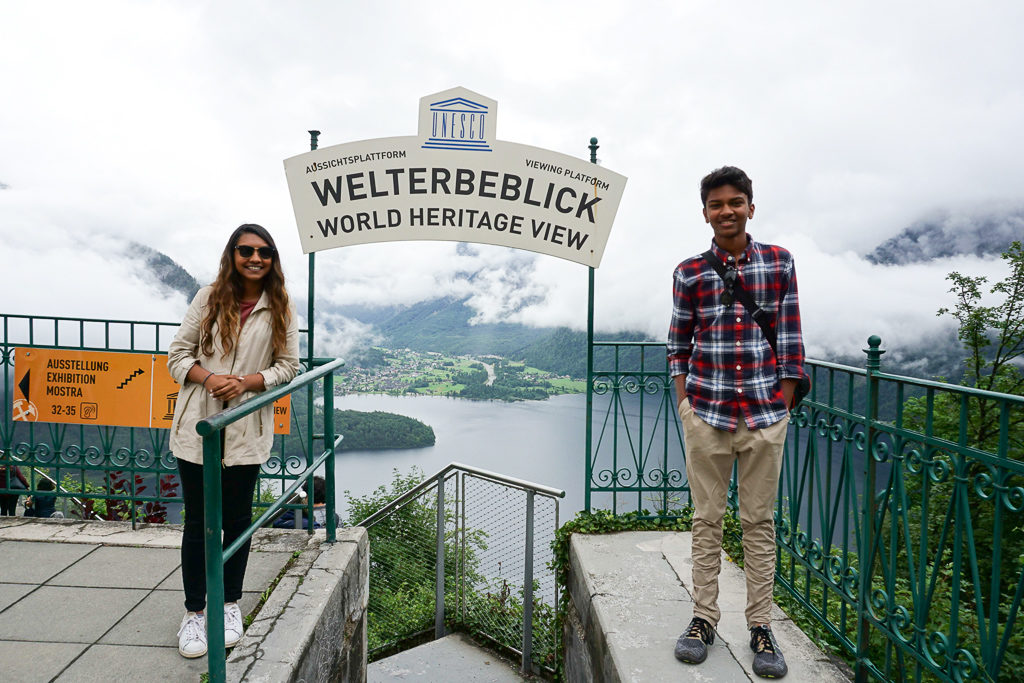
Salt Mine Tour at Salzwelten
A peek at the Man in Salt was our first stop before heading to the Salt mine tour. The Man in Salt was discovered in 1734 when the body of a former miner was found, perfectly preserved in salt. Records describe the corpse as being “pressed flat as a board and features worn away by stone. Clothing and tools quite unusual, but completely intact.” You would think that the discovery of concrete in the mine from 1,500 BC would make this an old salt mine, but it’s actually much older. In 1838, workers found a pick made of staghorn from the Neolithic Age dating back to 5,000 BC. This find makes Salzwelten the oldest salt mine in the World at over – about 7,000 years old!!! These discoveries, along with other finds from the early Iron Age, have led historians to call the period from 800-400BC the Hallstatt Era. Once we made our way up the line to enter the Salt mine, we changed into our miner clothes that were provided.
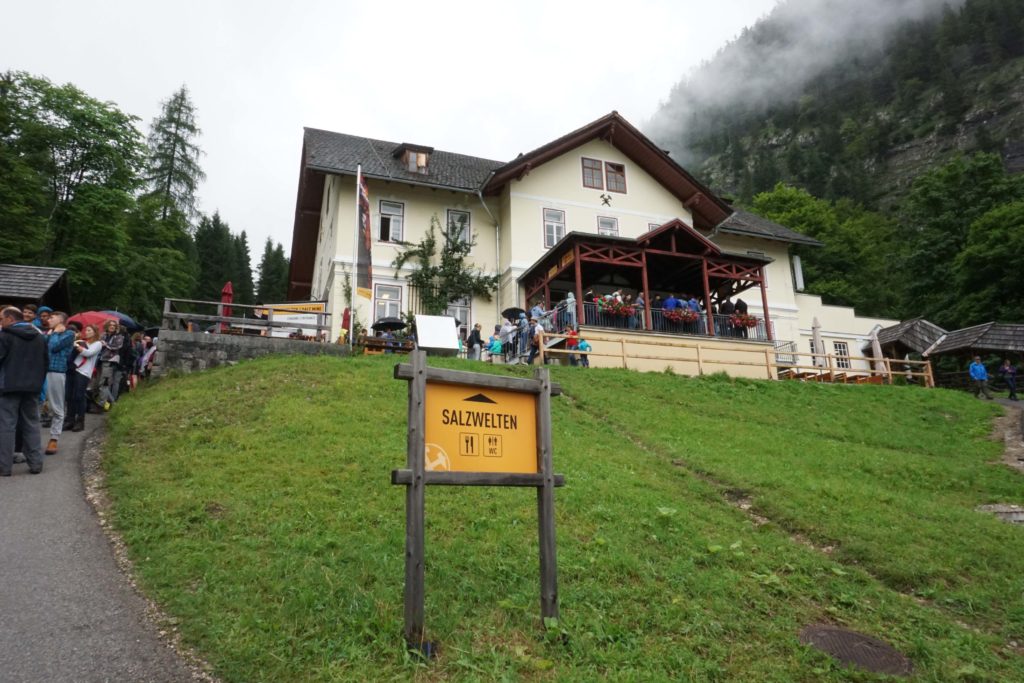
Some 50 millions of millions of tons of salt are in our seas. Salt has many uses, and the world population consumes about 150 million tons per year. The tour guide talked about the history of the Salt in Austria and how it was formed millions of years ago when Earth shifted and Hallstatt mountains were formed from what used to be an ocean. Until the early Middle Ages, salt was mined exclusively as rock salt. Then, solution mining took over. Its principle is simple: fresh water is introduced into the saliferous mountain, the water will dissolve the salt while the non-soluble parts will sink to the ground of the leaching chamber. The saturated brine, i.e., the water containing about 26% of salt, is then conveyed out of the mountain. Originally, the brine was scooped from the leaching chamber with buckets by the aid of a winch. Later, an outlet box was used to control the flow of the brine to the gallery level underneath. Nowadays, the brine is pumped upwards. Until 1964, further processing took place in Hallstatt’s brine coppers, since then the brine has been worked in the modern salt plant at Ebensee.

We visited the mine’s underground lake, learned about the mining process, saw some large salt blocks and even went on a thrilling ride down the old wooden miners’ slide and a ride on cool old miner train. There are two slides at the Salzwelten Hallstatt just like the ones the miners used for moving from one level to the one below. Although a little intimidating at first, it was fun to slide on them and have our speed clocked using a radar. We even a saw bronze age cinema that shows the oldest staircase in the world that was also discovered in the mine. Visiting the salt mine was fun for the entire family and we learned so much about the salt formation in the mountains and the mining process.
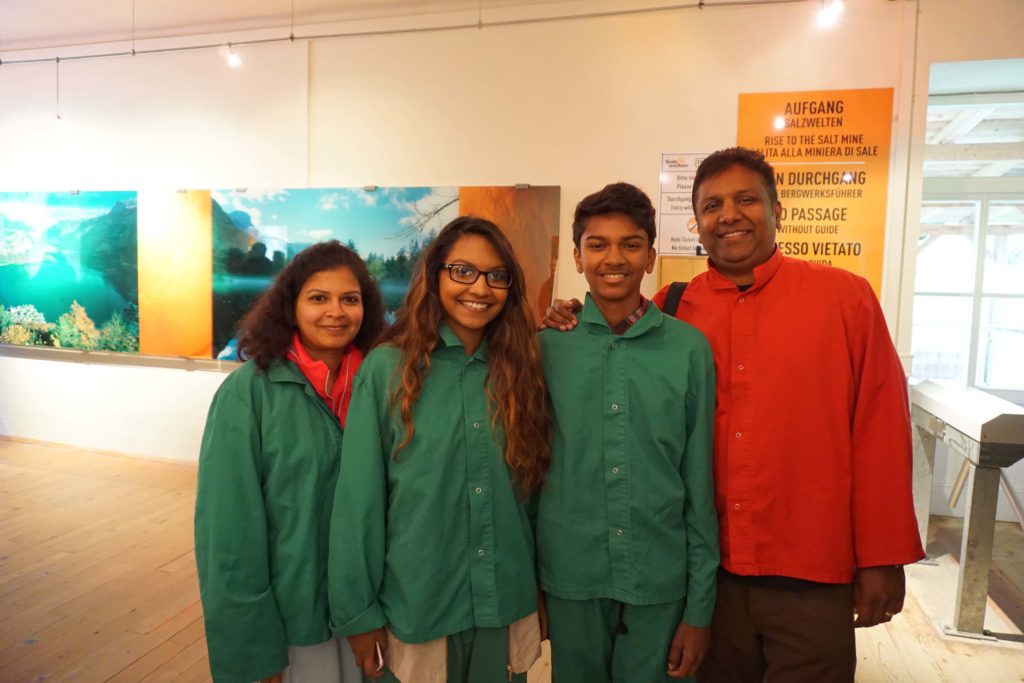
The Salt Brine Trail
If you are up to some hiking and looking for some stellar views of Hallstatt, then the Salt Brine Trail is a wonderful alternative to the funicular for heading back down the hilltop to town. The trail follows the world’s oldest brine pipeline, established in 1607, which sent salt brine down to Hallstatt and surrounding towns to be processed into pure salt. In addition to gorgeous wooded paths and stunning views, you’ll also pass by the Franz Joseph Tunnel and the impressive Mühlbach (mill brook) Waterfall which cuts through the heart of town. The large mansions near the waterfall were once the grain mills that produced Hallstatt’s flour. While the full trail heads North of Hallstatt for another 40km, the local section ends at the parking lot near the Catholic Church and Bone House. We skipped this since it was raining and headed back down on the funicular and stopped for coffee in Hallstatt town center.
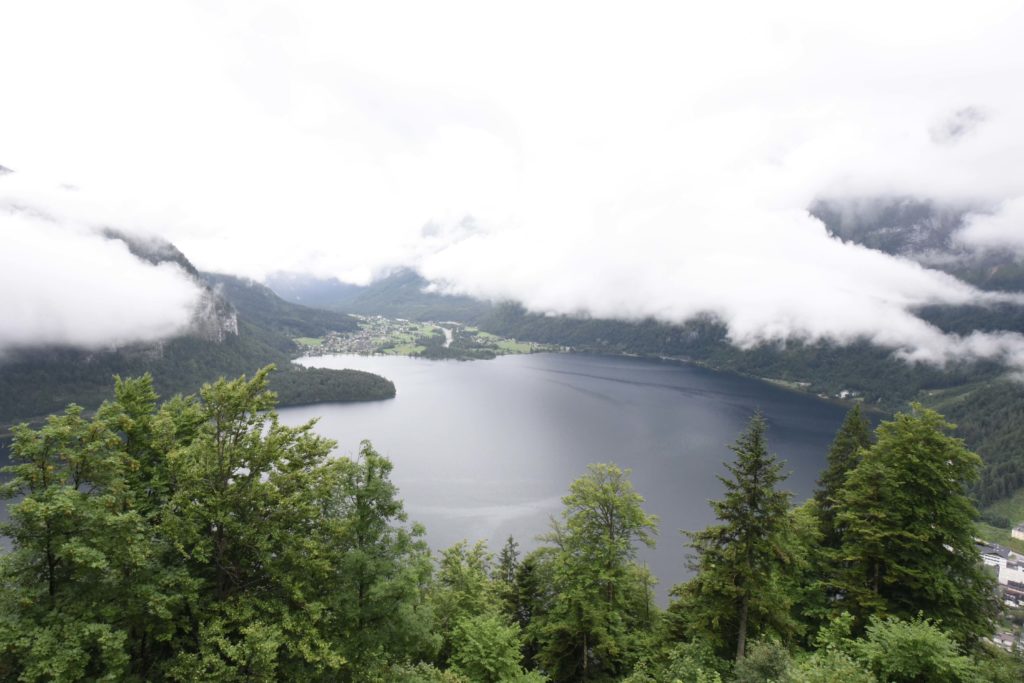
Additional Information
You must get on the funicular at least 30 minutes prior to the last Salt Mine tour departure in order to make it up in time including the hike and getting changed into your provided “miner” clothes. It was a good 15 to 20-minute hike from the funicular to the entrance of the Salt mine tour. On the way back, if you miss the last funicular it is a steep 45 to 1-hour hike down to Hallstatt on the steep, but enjoyable Brine Trail. The Hallstatt Salt Mine tours take about 90 minutes, but we recommend to plan about 2.5 hours in total (salt mine tour with the funicular railway, walk to the salt mine entrance and back and to visit the Hallstatt Skywalk “Welterbeblick”) You can buy tickets online to avoid waiting in line.
If you don’t have a car and want a tour option then there is a private tour of Hallstatt from Salzburg that follows a similar itinerary.
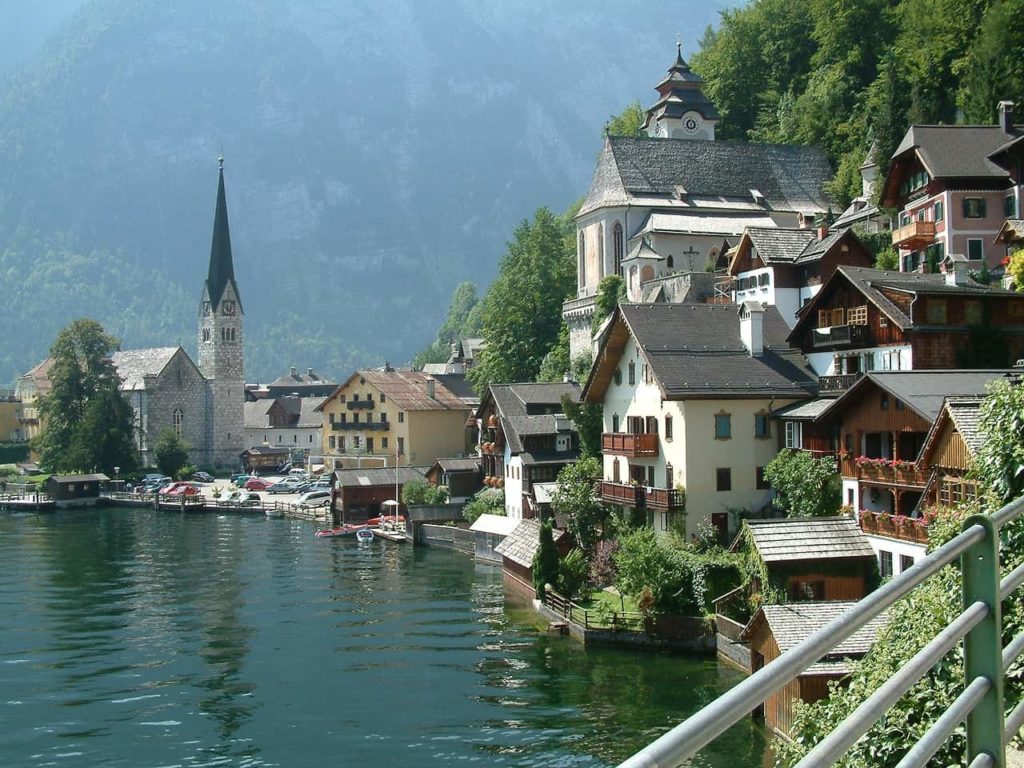
Tip : Apart from the view of the village and the lake from the funicular, there are a couple of places to get the classic Hallstatt shot. One is from the “Classic Village Viewpoint”. This is along the Gosaumühlstraße just a little north from the Hallstatt Lutheran Church in the center of the village. There aren’t that many roads and paths, walk along this road and you can’t miss it. The other is along Seelände, where you’ll get a completely different perspective from the south.
Salt Mine Tour Cost: Tour by itself is 22€ for Adults or 30€ for a tour with the round trip funicular ride; children 50% off; family passes were available. For the funicular, only the cost is a 16€ round trip or 9€ one way. Salt mine tours are two hour-long tours and run Daily the last week of April through late-September departing from 9:30am-4: 30 pm. Check their site for winter hours.
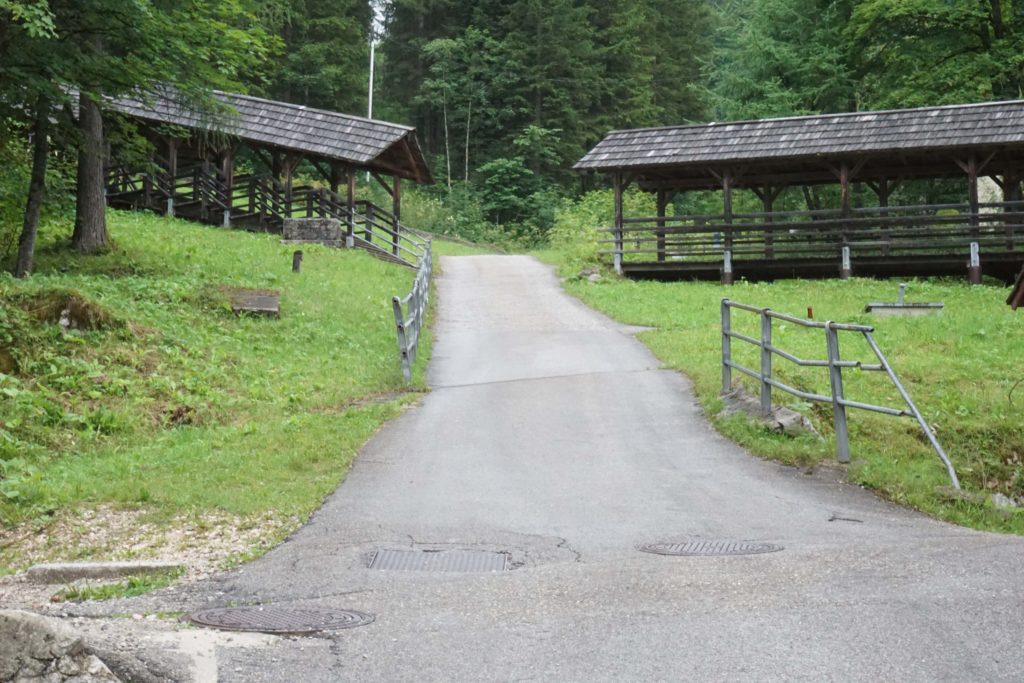
Couple of other things to see near Hallstatt
5 Fingers, a viewing platform in the Dachstein Mountains a ten minutes drive from Hallstatt, on Mount Krippenstein.
Krimml Waterfalls, the highest waterfall in Europe.
Lammerklamm, a Gorge that you can hike into to see rushing waters between steep canyons.
You might also like: Top Day Trips from Salzburg, Family-Friendly Guide to Vienna & 2 week Road trip Itinerary through Austria and Switzerland
PIN IT FOR LATER

Priya, thanks for the great article and reminder of our trip to Hallstatt! Did everything you mentioned here and it was probably our best village we visited anywhere in Austria!
This post brought back fond memories of my visit to Hallstat. What a stunning region. I am glad I had time to go to the salt mine tour as it was one of my favorites. The mine ride was definitely a highlight. I can’t wait to bring my boys there some day. Like you said, it is fun for the whole family.
I’ve been to Austria but only to Vienna. I love seeing photos of Hallstatt and would love even more to visit one day. We visited a salt mine in Poland last year. It was super cool!
Francesca – Hallstatt is very picturesque, we wish we have planned a couple of days there instead of just one. Hope you get to visit soon.
It’s a gorgeous place! We went a few years ago and have our own pics of us in those pajama like uniforms, plus the viewing platform etc. I thought it was a great day out. We have reports of it on our blog too!
My daughter also recently went to Austria, to Zell am See, and she visited the Grossglockner then and wrote about. This whole area is so delightful. Austria is a beautiful place, but then again, I’m a sucker for mountains and lakes.
I’ve been to Halstatt but only for a few hours so I didn’t get to visit the salt mine
Tanja – The salt mine visit took half a day, hope you get to visit next time.